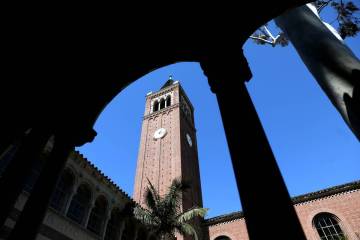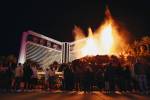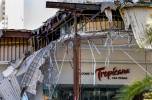Foam adorns many resorts
Many exterior features on the Strip's most recognizable hotel-casinos are made from the same material used to create the rooftop facade on the Monte Carlo, foam that might have fueled the Friday fire that closed the resort.
Construction, architectural design and gaming sources all said the building material, referred to as Exterior Installation and Finish System -- EIFS for short -- is one of the most commonly used products for finishing and design work, and has been used on many Strip resorts. Sources said exterior design work at Bellagio, Paris Las Vegas, Excalibur, Treasure Island, Caesars Palace and New York-New York all include EIFS products, which can be molded and sculpted to form many shapes.
"It's pretty much everywhere. We use it probably 95 percent of the time on our projects," said Dick Rizzo, vice chairman of Perini Building Co. Perini did not work on the Monte Carlo, which opened in 1996, but has been involved in several Strip developments. The company is the general contractor on the $7.8 billion CityCenter and the $1.2 billion Trump International Hotel & Tower.
According to construction experts, EIFS is used on all types of buildings, including homes, apartments, condominiums, offices, shopping centers, hospitals, hotels, stadiums and government buildings. The product is a Styrofoam-like substance that has flammable ingredients. However, because building codes require it to be encapsulated behind stucco and other cementlike materials, its flammability can be reduced.
As its name suggests, EIFS should be used only in exterior construction, said Robert Thomas Jr., a Jacksonville, Fla., architecture consultant who operates a Web site dedicated to the usage of EIFS.
In an August 2004 article that appeared on an Internet site for the wall and ceiling building industry, Thomas said fire codes restrict EIFS materials' use as a reliable indoor construction product.
"The codes require that if foam plastic insulation is used indoors, then the foam must be separated from the interior space by a material with a 15-minute fire rating," Thomas wrote. "This is why EIFS should not be used indoors."
Clark County building department officials were unaware of any use of EIFS materials inside any Strip resorts.
"As far as we're aware, this is primarily an exterior material," Clark County spokesman Dan Kulin said.
The fact that EIFS products were used on the Monte Carlo did not concern building sources as they watched last week's fire spread across the upper levels of the hotel's south tower of the 32-story hotel-casino. They did, however, question whether the material was properly secured and sealed during the initial construction of the resort.
"Those were chunks of EIFS you saw falling from the roof," said one Strip design expert who asked not to be named. "That thickness is not used anymore."
Clark County building officials told the Review-Journal last week that building codes governing the use of EIFS have become more strict since the Monte Carlo opened. In the past 12 years, the codes have reduced the allowable thickness of the EIFS and changed requirements on encapsulating the foam material.
The Monte Carlo, modeled after the Place du Casino in Monte Carlo, opened at a cost of $344 million after a nearly two-year construction process.
The resort was built as a joint venture initially between Mirage Resorts and Gold Strike Resorts. Circus Circus Enterprises, which was renamed the Mandalay Resort Group in 1999, acquired Gold Strike in March 1995 while the Monte Carlo was under construction. MGM Mirage acquired the hotel-casino through its separate buyouts of Mirage in 2000 and Mandalay in 2005. Circus Circus/Mandalay was the operating partner until MGM Mirage took control of the resort.
Circus Circus Development, the company's in-house construction company, served as general contractor on the project. Circus Circus Development was assisted by Las Vegas company M.J. Dean Construction.
Through a spokesman, former Circus Circus/Mandalay Resorts President Glenn Schaeffer declined comment on the Monte Carlo fire and construction.
The Monte Carlo's architects were Neal Gaskin and Ilia Bezanski. The pair also designed the New York-New York. Dougall Design, a Pasadena, Calif., based interior design firm with a long history of projects on the Strip, designed the Monte Carlo's interiors.
On their corporate Web sites, Dougall and M.J. Dean have pages dedicated to their work on the Monte Carlo. Officials from both companies did not return phone calls.
Contact reporter Howard Stutz at hstutz @reviewjournal.com or (702) 477-3871.
RESERVATIONS SHIFT The Monte Carlo will continue moving hotel and convention reservations to other resorts through next week while repairs continue on the fire-damaged high-rise, MGM Mirage announced Wednesday. The hotel has been closed since friday, when flames burned across the upper facade of the resort. Company officials continued the around-the-clock task of assessing and repairing fire, smoke and water damage Wednesday. They had not determined a timetable for reopening. County building officials have said they will not OK the reopening until charred debris on the facade is removed or secured to prevent it from falling. Meanwhile, Clark County fire investigators continued probing the blaze and had not determined a cause. Monte Carlo officials have relocated more than 100 meetings and events to other hotels, including some not owned by MGM Mirage, the company said. Incoming Monte Carlo guests can call 888-395-0776 and employees can call 693-7005 for info. REVIEW-JOURNAL View photos and video of the fire




























